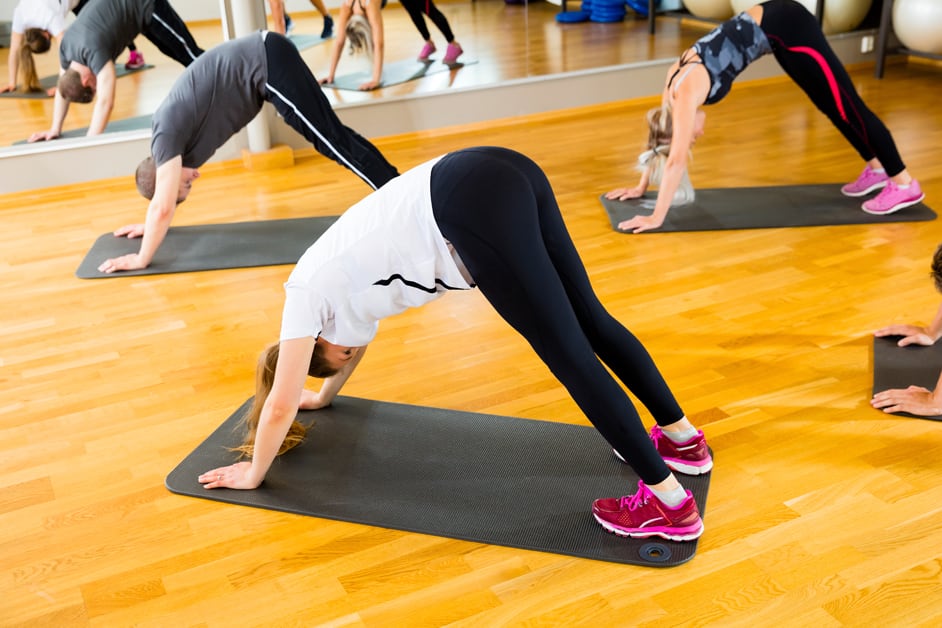Introduction
Knee ligament injuries can cause bother for yoga practitioners. Too much pressure or movement can be painful and could even lead to harm. While the knee is important for many poses, it is possible to practice yoga without putting strain on the injury area.
This guide provides advice for recognizing poses that might worsen an existing knee injury. It also offers alternative poses that suit any restrictions due to a knee injury while still giving a satisfying physical experience.
If you follow these ideas, you can become aware of the intensity and kind of pain you may feel in certain poses. These are poses you should stay away from or modify to fit your needs.
Anatomy of the Knee
The knee joint is complex. Bones, ligaments, tendons and muscles are all involved. Those practicing yoga with a knee ligament injury should understand the anatomy of this joint. Sprains and strains of the ligaments can harm the knees. So, let us look at the anatomy of the knee and the kind of ligament injuries that can happen.
Ligaments of the Knee
Four main ligaments hold the knee joint together. These are strong fibrous bands that join two bones and stop too much movement. When these ligaments are harmed, it can cause pain, swelling, and other issues.
The MCL is on the inner side. It links the femur to the tibia and stops side-to-side motion. The LCL is on the outer side. It ties the femur to the fibula and keeps the leg from moving away from the middle.
The ACL and PCL form an “X” in front and behind the knee. They attach the thigh bone to the shin bone in a diagonal way. This gives the knees support when walking or running. It’s important to bear this in mind when doing activities that involve quick acceleration or stopping motions.
Common Knee Ligament Injuries
Knee ligament injuries are often seen in both pro-athletes and regular people. Such injuries include sprains, when a ligament is pulled beyond its typical range of motion, and tears when a ligament is ruptured. These can be caused by sudden movements or falls while doing activities such as running, jumping, landing wrong from a jump, or turning the knee while planting the foot or altering direction quickly.
The key knee ligaments are:
- Anterior cruciate ligament (ACL): Joins the femur to the tibia; assists in stabilizing the knee joint.
- Posterior cruciate ligament (PCL): Joins the femur to the tibia; helps stabilize back portion of knee joint.
- Medial collateral ligament (MCL): Connects inner side of shin bone to inner side of thigh bone; help control sideways motion at knee joint.
- Lateral collateral ligament (LCL): Connects outer side of shin bone to outer side of thigh bone; help control sideways motion at knee joint.
As these joints are fragile, one must be careful when doing activities with a high risk for injury, like running and jumping games. When doing yoga with an injured knee, it’s best to be aware of poses that could put extra strain on the joints and modify them for individual needs.
Yoga Poses to Avoid
Knee ligament injuries require special attention for yoga practice. Be mindful of poses that could cause trouble for the injured spot, and alter them. This passage looks into the poses that should be avoided or changed to keep the joint secure.
High-Impact Poses
High-impact poses can be risky. They involve a sudden jolt of energy. Harvard Health says they can strain joints, muscles, and bones. Listen to your body’s feedback. Exercise caution when trying higher-impact poses. When done safely, they can increase strength and endurance.
The following postures are more likely to cause injury:
- Jump Backs
- Jump Throughs
- Competitive Poses
- Arm Balances
- Headstands & Handstands
- Full Inversion Poses
Deep Squats
Deep squats can strain your knees and lower back. Avoid them if you can! To lessen strain, keep your torso straight, with a slight tilt at the hips. Instead, try alternative poses that don’t require you to go so low.
If you want to experience a deeper squat, try widening your feet and pointing your toes outwards. This will allow for more outward rotation of the legs. You can then experience deeper ranges of motion without straining your body. Consider:
- Utkatasana
- Virabhadrasana III
- Ardha Uttanasana
- Vrksasana
Inversions
Inversions are great for opening the spine and calming the mind. It is important to remember that not everyone is suitable for these poses. Some people may have restrictions because of their physical or medical condition. Pay attention to any pain or strange sensations while practicing.
Inversions are poses where the head is lower than the heart, such as Downward-Facing Dog and Headstands. Some variations are:
- Shoulder Stand: This requires keeping the shoulders and head off the ground.
- Plow Pose: Here legs are kept perpendicular to the torso.
- Headstand: Both legs are above the hips, with hips over shoulders.
- Handstand: An advanced pose requiring balance and strength with only hands touching the ground.
- Fish Pose: A less demanding version where you lay lengthwise on a bolster and rest on elbows.
When doing yoga poses, listen to your body. For inversions, start slowly and take guidance from a qualified instructor. If you experience pain or unusual sensations during practice, stop and ask for help if needed.
Twists
Twists are a part of yoga classes, but newcomers should avoid certain poses. Pay attention to your body and ease into positions. Don’t push past limits and watch for signs of injury.
- Sit on the floor with legs crossed. Twist your torso slowly to one side. Don’t force it.
- On an inhalation, rise from the twist. Take five slow breaths. On an exhalation, come back into the twist.
Remember to keep your neck neutral as you stretch. Don’t tilt it up or down. And if you have a lower back injury, avoid twisting postures. Get advice from a qualified yoga instructor if needed.
Modifications for Knee Ligament Injuries
Yoga is great for those who have hurt their knee ligaments. There are modifications to help them get a complete body stretch and workout, while avoiding damage to the knee. This article talks about the modifications needed and which poses to change or avoid:
Low-Impact Poses
Knee ligament injuries can make poses painful. To avoid this, it is good to do low-impact poses that don’t put stress on the joint. Knee flexion poses should be avoided because they can overstretch the ligament. Instead, focus on postures that strengthen muscles around the knee, like:
- Half chair
- Downward facing dog
- Low lunge
- Child’s pose
- Warrior III
For extra support, use a yoga block or towel between your knees. Or, wrap a band or strap around them. Remember to listen to your body and modify poses to feel comfortable.
Chair Poses
Chair poses are a great way to help rehabilitate knee ligament injuries. They are simple, require no equipment, and increase strength and coordination.
Single-leg balance is essential for strengthening the ligaments around the knee joint. Adjustments can be made for any limitations in strength or range of motion. Try using a wall for propulsive assistance, or sit on a chair just a few inches off the ground.
Chair poses provide dynamic body weight squats and single-leg balance. This helps develop the ability to control movement and stability at the same time.
Incorporating single-leg balance exercises is beneficial for those recovering from knee ligament injuries. It strengthens key stabilizing muscles around their hips and knees. Chair poses can be easily adjusted according to an individual’s progression level. This allows them to gain strength while promoting stability in their injured joint area.
Forward Folds
Forward folds can help to stretch and relax knee ligaments. If you feel pain or unease, rest and modify your forward folds. A strap around the feet can give you support, keep you in the right alignment, and allow you to deepen the fold with each breath.
Alternatively, do bent-knee folds. Place your legs apart with bent knees, feet on the floor. Clasp one knee at a time and pull towards you for a hip opener. But, many sources discourage this pose. If you feel discomfort, stop.
Lastly, if you want an easier exercise or want to focus on stretching other body parts, try seated wide-angle poses instead of full forward folds. Put your feet firmly on the mat and don’t round your back or do any movement that causes pain.
Side Bends
Side bends are great for those with knee ligament injuries.
- Stand on one leg. Foot slightly apart.
- Arms stretched out in front of you.
- Bend your standing leg a bit.
- Lower your hands towards your foot.
- Feel the stretch at the sides of your hips.
- Keep your abdomen tight.
- Come back up to the starting position.
Exercise can be modified.
- Widen the stance or decrease intensity of the stretch.
- Use an exercise band or loop around your waist for increased resistance.
Start with 10 reps. Gradually increase as advised by a physical therapist or doctor.
Conclusion
Yoga can be a great way to help heal and protect your knees from further injuries. Pick poses wisely, avoiding any that require forceful extension. Modify poses to decrease stress, or do hip openers for a better stretch. Keep your awareness on what feels comfortable. Stick with any modifications that allow you to practice safely. With proper rest and maintenance, you’ll be back on your mat soon.
Mindfully Navigate Through Your Healing Process!
Frequently Asked Questions
Q: Are there any specific poses I should avoid if I have a knee ligament injury?
A: Yes, any poses that involve deep knee bends such as Warrior I and II, and Half Moon Pose should be avoided. It is also recommended to avoid poses that require the knee to be bent for an extended period of time such as Chair Pose.
Q: Are there any poses that I can modify to be gentle on my injured knee?
A: Yes, many poses can be modified to be gentle on the knee. For example, instead of full Downward Dog, you can do a Half Downward Dog with one leg raised in the air. You can also use props such as blocks and blankets to support the knee in poses such as Triangle Pose and Warrior III.
Q: Are there any exercises I can do to help strengthen my knee?
A: Yes, you can do simple exercises such as straight leg raises and bent knee raises to help strengthen the muscles around the knee. You can also use resistance bands or other light weights to add more resistance to the exercises.





